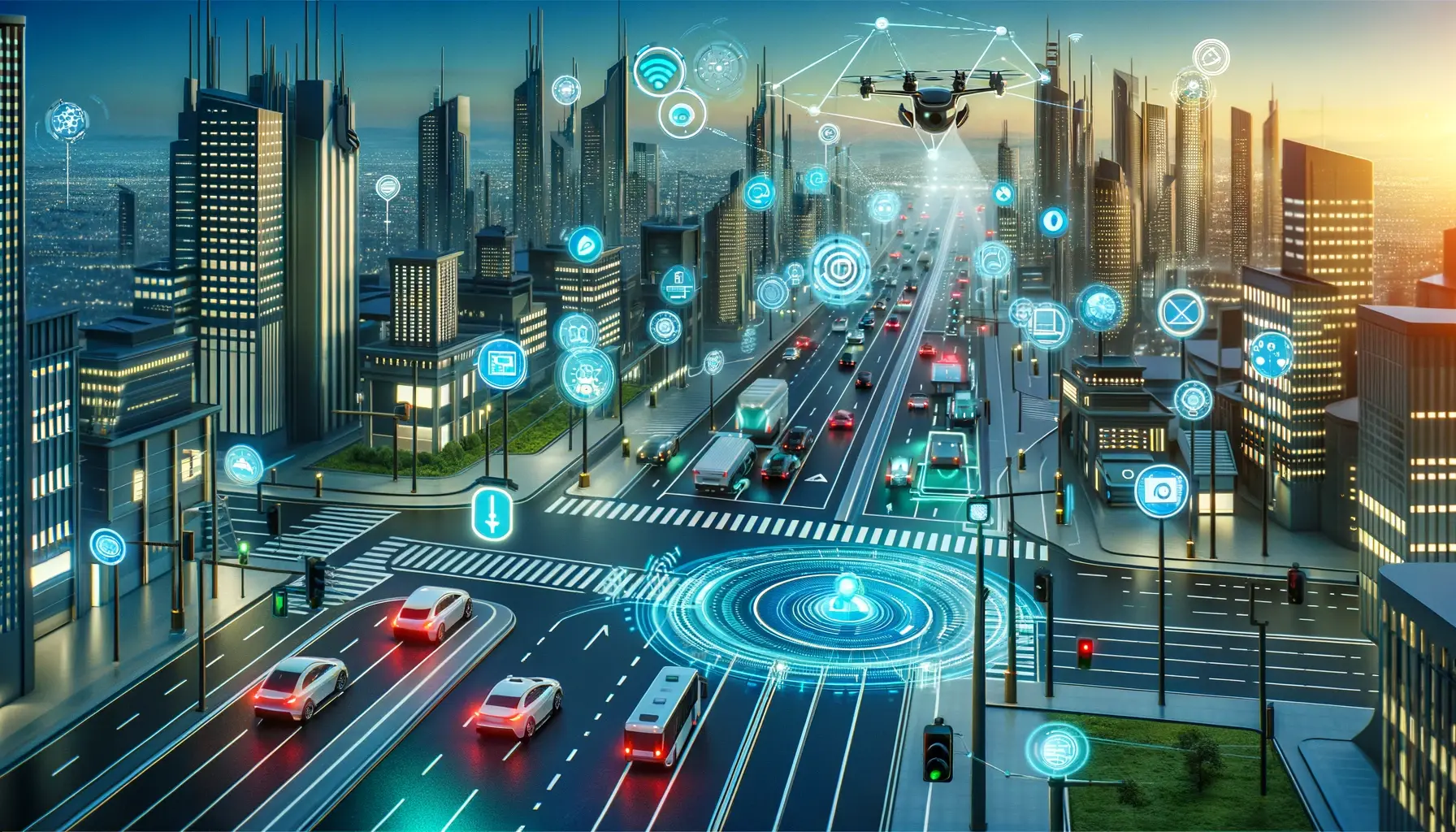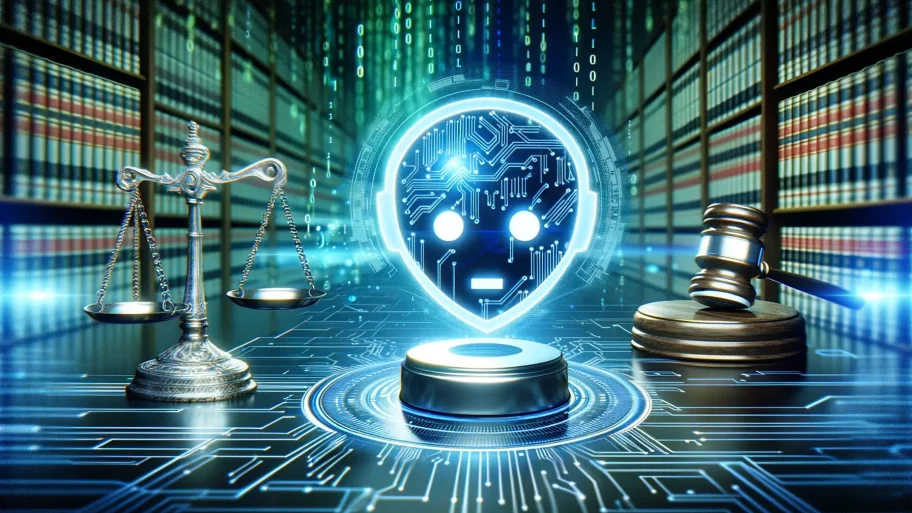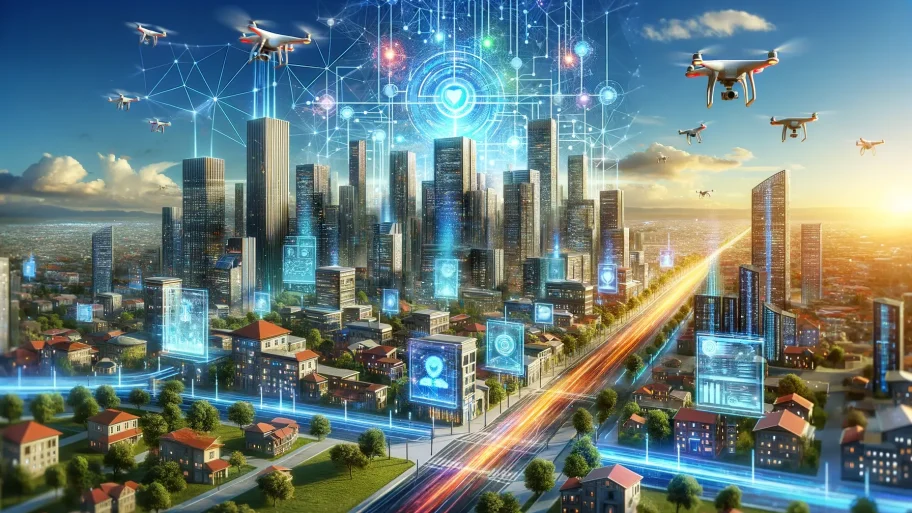Top 5 AI Use Cases In Public Safety Traffic Management
- By Matt

Attention Traffic Management Professionals and Urban Planners!
Are you prepared for the chaos of unmanageable traffic, delayed emergency responses, and increased accidents? These threats are imminent for those who fail to adopt AI in public safety traffic management today.
In this article, we’ll reveal how AI can revolutionize traffic management, helping you avoid these critical issues.
Key Takeaways
- Real-Time Traffic Monitoring provides dynamic insights and improves traffic flow.
- Predictive Traffic Congestion Management alleviates traffic congestion before it occurs.
- Automated Incident Detection and Response reduces emergency response times.
- Smart Traffic Signal Control optimizes traffic signal timings based on real-time data.
- Vehicle-to-Everything (V2X) Communication enhances communication between vehicles and infrastructure.
Use Case #5: Vehicle-to-Everything (V2X) Communication
Starting our countdown at number 5 is the transformative use of V2X communication, which enhances the interaction between vehicles and infrastructure for improved safety and efficiency.
The Danger of Poor Communication
Without effective communication, vehicles and infrastructure operate in isolation, leading to traffic inefficiencies and increased accident risks. This lack of coordination can cause severe disruptions and safety hazards.
The inability to communicate seamlessly adds stress to traffic management, making it difficult to ensure smooth and safe traffic flow.
Risks of Poor V2X Communication
- Increased accident risk
- Traffic inefficiencies
- Higher operational stress
- Reduced traffic safety
How AI Improves V2X Communication
AI-enhanced V2X systems enable vehicles to communicate with each other and with traffic infrastructure in real-time. This improves traffic efficiency and safety by providing timely information about traffic conditions and hazards.
Implementing AI for V2X communication ensures better coordination, reduced accidents, and optimized traffic flow.
Table 1: Key Benefits of AI-Enhanced V2X Communication
| Benefit | Description |
|---|---|
| Improved Safety | Real-time communication reduces accident risks |
| Enhanced Efficiency | Optimized traffic flow through coordinated movements |
| Cost Savings | Reduced accident and operational costs |
| Real-Time Information | Timely updates on traffic conditions and hazards |
Table 1 highlights the significant benefits of implementing AI-enhanced V2X communication within traffic management systems.
Future of V2X Communication
AI-powered V2X communication revolutionizes traffic management by providing seamless interaction between vehicles and infrastructure. This integration minimizes accidents and enhances traffic efficiency.
As AI technology evolves, V2X systems will become even more sophisticated, further improving safety and traffic management efficiency.
Use Case #4: Smart Traffic Signal Control
Using AI for smart traffic signal control optimizes signal timings based on real-time data, improving traffic flow and reducing congestion.
The Chaos of Inefficient Traffic Signals
Poorly timed traffic signals lead to unnecessary congestion and delays. This inefficiency not only frustrates drivers but also increases fuel consumption and pollution.
The chaos caused by inefficient traffic signals adds stress to managing urban traffic, impacting overall efficiency and public satisfaction.
Challenges with Traffic Signal Timing
- Increased congestion
- Higher fuel consumption
- Increased pollution
- Driver frustration
AI-Optimized Traffic Signals
AI uses real-time traffic data to adjust signal timings dynamically, ensuring optimal flow and reducing congestion. This adaptive approach minimizes delays and improves overall traffic efficiency.
Implementing AI for traffic signal control ensures smoother traffic flow, reduced emissions, and enhanced driver satisfaction.
Table 2: Key Benefits of AI-Optimized Traffic Signals
| Benefit | Description |
|---|---|
| Reduced Congestion | Optimized signal timings improve traffic flow |
| Lower Emissions | Less idling reduces pollution |
| Fuel Savings | Efficient traffic flow decreases fuel consumption |
| Driver Satisfaction | Reduced delays enhance driving experience |
Table 2 outlines the benefits of AI-optimized traffic signals for urban traffic management.
AI’s Role in Signal Control
AI-driven traffic signal control addresses the inefficiencies of traditional signal systems, ensuring smoother and more efficient traffic flow. This technology enhances urban mobility and reduces environmental impact.
As AI continues to develop, traffic signal systems will become even more responsive and adaptive, further improving urban traffic management.
Use Case #3: Automated Incident Detection and Response
Implementing AI for automated incident detection and response reduces emergency response times and enhances overall traffic safety.
The Threat of Slow Incident Response
Delayed responses to traffic incidents can result in severe consequences, including increased casualties and prolonged congestion. Slow response times hinder emergency services and exacerbate traffic disruptions.
This threat of slow incident response adds stress to traffic management, compromising safety and efficiency.
Consequences of Delayed Incident Response
- Increased casualties
- Prolonged congestion
- Higher emergency response costs
- Reduced traffic safety
AI-Driven Incident Management
AI-driven systems detect traffic incidents in real-time and automatically alert emergency services. This rapid detection and response minimize delays and improve overall safety on the roads.
Implementing AI for incident detection and response ensures quicker emergency interventions, enhancing traffic safety and efficiency.
Table 3: Key Benefits of Automated Incident Detection
| Benefit | Description |
|---|---|
| Quicker Response | Rapid incident detection reduces response times |
| Improved Safety | Faster interventions minimize casualties |
| Reduced Congestion | Prompt responses clear incidents faster |
| Cost Savings | Efficient incident management lowers emergency costs |
Table 3 highlights the benefits of automated incident detection and response for traffic safety.
Advancements in Incident Response
AI-driven incident detection transforms emergency response by enabling real-time monitoring and rapid interventions. This technology minimizes the impact of traffic incidents and enhances road safety.
As AI technology advances, incident detection systems will become even more accurate and responsive, further improving traffic management and safety.
Use Case #2: Predictive Traffic Congestion Management
Using AI for predictive traffic congestion management helps alleviate congestion before it occurs, enhancing traffic flow and reducing delays.
The Perils of Unmanaged Congestion
Unmanaged traffic congestion leads to significant delays, increased fuel consumption, and heightened stress for drivers. Prolonged congestion can disrupt daily commutes and negatively impact economic productivity.
The perils of unmanaged congestion add stress to urban traffic management, affecting both public satisfaction and economic performance.
Impacts of Traffic Congestion
- Increased delays
- Higher fuel consumption
- Economic productivity loss
- Driver frustration
AI-Powered Congestion Management
AI uses machine learning algorithms to predict traffic patterns and identify potential congestion points before they become problematic. This proactive approach allows for dynamic adjustments to traffic flow, reducing delays and improving efficiency.
Implementing AI for congestion management ensures smoother traffic flow, lower fuel consumption, and enhanced driver experience.
Table 4: Key Benefits of Predictive Congestion Management
| Benefit | Description |
|---|---|
| Reduced Delays | Proactive management minimizes congestion |
| Fuel Savings | Efficient traffic flow lowers fuel consumption |
| Economic Benefits | Smoother traffic flow boosts productivity |
| Improved Driver Experience | Less congestion reduces driver stress |
Table 4 outlines the benefits of predictive congestion management in urban traffic systems.
How AI Mitigates Congestion
AI-driven congestion management transforms urban traffic by predicting and addressing congestion points proactively. This technology ensures smoother traffic flow, reducing delays and enhancing overall efficiency.
As AI continues to advance, congestion management systems will become even more effective, further minimizing traffic disruptions and improving urban mobility.
Use Case #1: Real-Time Traffic Monitoring
Leveraging AI for real-time traffic monitoring provides dynamic insights into traffic conditions, enabling immediate adjustments to traffic signals and routing.
The Chaos of Static Traffic Monitoring
Static traffic monitoring systems fail to adapt to changing traffic conditions, leading to inefficiencies and increased congestion. Without real-time insights, traffic management becomes reactive rather than proactive.
The chaos caused by static monitoring adds stress to urban traffic management, impacting both efficiency and public safety.
Impacts of Static Monitoring
- Increased congestion
- Delayed response to traffic incidents
- Higher operational costs
- Reduced traffic efficiency
Real-Time Traffic Insights
AI-driven traffic monitoring systems provide real-time data on traffic conditions, allowing for immediate adjustments to traffic signals and routing. This dynamic approach minimizes delays and improves traffic flow.
Implementing AI for real-time traffic monitoring ensures better traffic management, reduced congestion, and enhanced public safety.
Table 5: Key Benefits of Real-Time Traffic Monitoring
| Benefit | Description |
|---|---|
| Dynamic Adjustments | Real-time data allows for immediate traffic management actions |
| Reduced Congestion | Proactive management minimizes traffic delays |
| Enhanced Safety | Better monitoring improves response to incidents |
| Operational Efficiency | Real-time insights streamline traffic operations |
Table 5 highlights the significant benefits of real-time traffic monitoring for urban traffic management.
The Role of AI in Real-Time Monitoring
Real-time traffic monitoring revolutionizes traffic management by providing dynamic insights and enabling proactive actions. This technology enhances traffic flow, reduces congestion, and improves public safety.
As AI technology advances, real-time monitoring systems will become even more sophisticated, further enhancing traffic management efficiency and safety.
Conclusion
In the rapidly evolving field of traffic management, inefficiencies, delays, and safety risks are critical challenges that must be addressed immediately.
Neglecting to adopt these AI-driven solutions means missing out on opportunities for increased efficiency, cost savings, and enhanced public safety.
Latest Posts
- By Matt | 9 months ago
- By Matt | 1 year ago
- By Matt | 1 year ago
- By Matt | 1 year ago
- By Matt | 1 year ago
- By Matt | 1 year ago
- By Matt | 1 year ago
There are no results matching your search Reset filters?
Trending
There are no results matching your search Reset filters?






